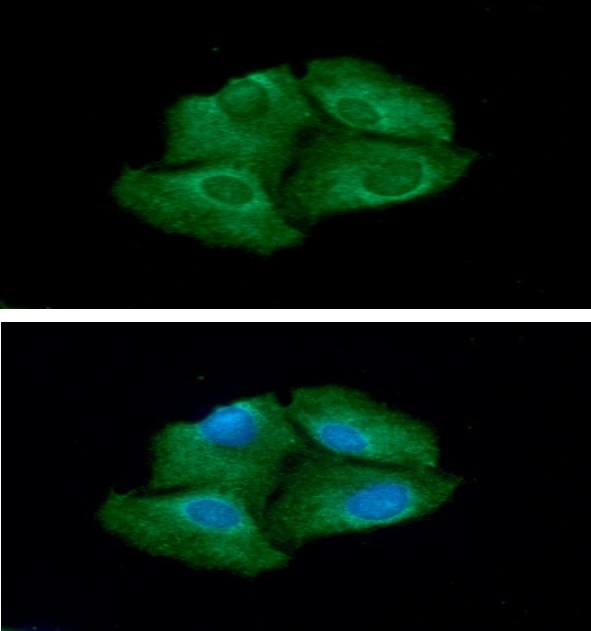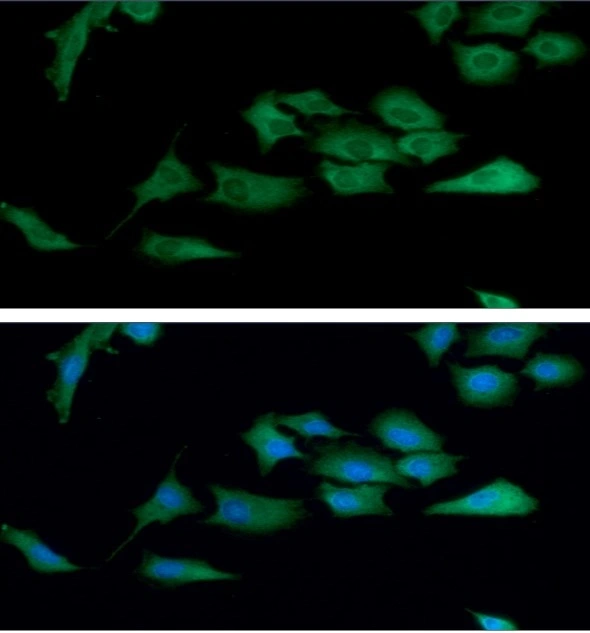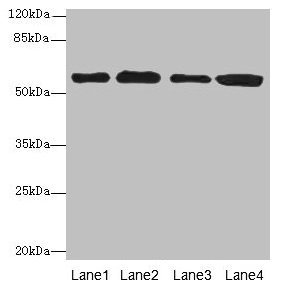
ICC/IF analysis of Hep3B cells using GTX57697 TrxR1 antibody. Blue: DAPI Green: Primary antibody Dilution: 1:100
TrxR1 antibody [AT30F1]
GTX57697
ApplicationsImmunoFluorescence, Western Blot, ImmunoCytoChemistry
Product group Antibodies
TargetTXNRD1
Overview
- SupplierGeneTex
- Product NameTrxR1 antibody [AT30F1]
- Delivery Days Customer9
- ApplicationsImmunoFluorescence, Western Blot, ImmunoCytoChemistry
- CertificationResearch Use Only
- ClonalityMonoclonal
- Clone IDAT30F1
- Concentration1 mg/ml
- ConjugateUnconjugated
- Gene ID7296
- Target nameTXNRD1
- Target descriptionthioredoxin reductase 1
- Target synonymsGRIM-12, TR, TR1, TRXR1, TXNR, TXNR1, thioredoxin reductase 1, cytoplasmic, KM-102-derived reductase-like factor, gene associated with retinoic and IFN-induced mortality 12 protein, gene associated with retinoic and interferon-induced mortality 12 protein, oxidoreductase, peroxidase TXNRD1, selenoprotein TXNRD1, testis tissue sperm-binding protein Li 46a, thioredoxin reductase GRIM-12, thioredoxin reductase TR1
- HostMouse
- IsotypeIgG2b
- Protein IDQ16881
- Protein NameThioredoxin reductase 1, cytoplasmic
- Scientific DescriptionThe protein encoded by this gene belongs to the pyridine nucleotide-disulfide oxidoreductase family, and is a member of the thioredoxin (Trx) system. Three thioredoxin reductase (TrxR) isozymes are found in mammals. TrxRs are selenocysteine-containing flavoenzymes, which reduce thioredoxins, as well as other substrates, and play a key role in redox homoeostasis. This gene encodes an ubiquitously expressed, cytosolic form of TrxR, which functions as a homodimer containing FAD, and selenocysteine (Sec) at the active site. Sec is encoded by UGA codon that normally signals translation termination. The 3 UTRs of selenoprotein mRNAs contain a conserved stem-loop structure, the Sec insertion sequence (SECIS) element, which is necessary for the recognition of UGA as a Sec codon rather than as a stop signal. Alternative splicing, primarily at the 5 end, results in transcript variants encoding same or different isoforms, including a glutaredoxin-containing isoform that is predominantly expressed in testis. [provided by RefSeq, May 2017]
- Storage Instruction-20°C or -80°C,2°C to 8°C
- UNSPSC12352203






